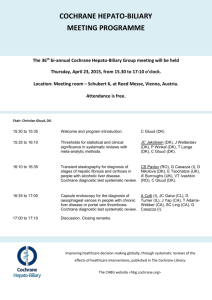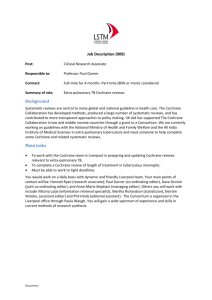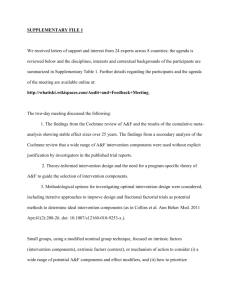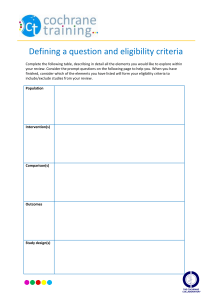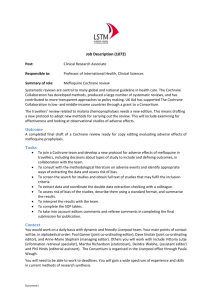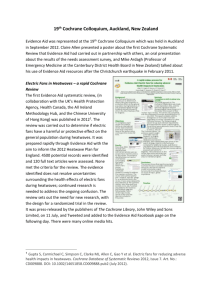2012-pfanderson-systematic-review
advertisement
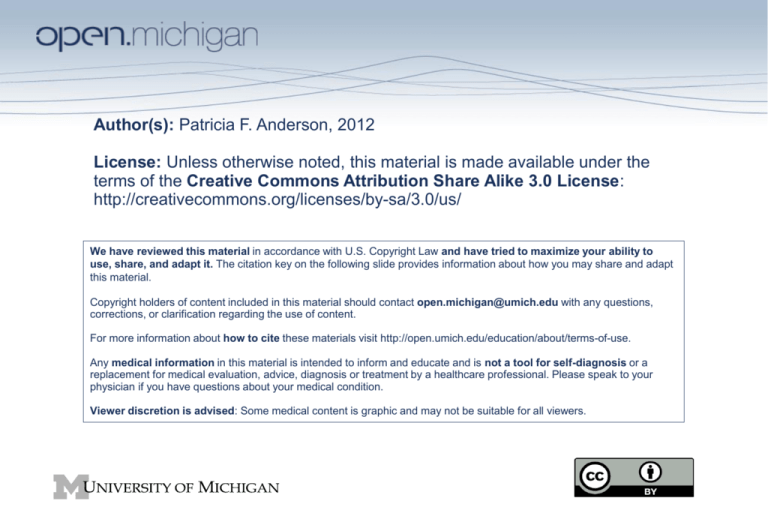
Author(s): Patricia F. Anderson, 2012
License: Unless otherwise noted, this material is made available under the
terms of the Creative Commons Attribution Share Alike 3.0 License:
http://creativecommons.org/licenses/by-sa/3.0/us/
We have reviewed this material in accordance with U.S. Copyright Law and have tried to maximize your ability to
use, share, and adapt it. The citation key on the following slide provides information about how you may share and adapt
this material.
Copyright holders of content included in this material should contact open.michigan@umich.edu with any questions,
corrections, or clarification regarding the use of content.
For more information about how to cite these materials visit http://open.umich.edu/education/about/terms-of-use.
Any medical information in this material is intended to inform and educate and is not a tool for self-diagnosis or a
replacement for medical evaluation, advice, diagnosis or treatment by a healthcare professional. Please speak to your
physician if you have questions about your medical condition.
Viewer discretion is advised: Some medical content is graphic and may not be suitable for all viewers.
Citation Key
for more information see: http://open.umich.edu/wiki/CitationPolicy
Use + Share + Adapt
{ Content the copyright holder, author, or law permits you to use, share and adapt. }
Public Domain – Government: Works that are produced by the U.S. Government. (17 USC § 105)
Public Domain – Expired: Works that are no longer protected due to an expired copyright term.
Public Domain – Self Dedicated: Works that a copyright holder has dedicated to the public domain.
Creative Commons – Zero Waiver
Creative Commons – Attribution License
Creative Commons – Attribution Share Alike License
Creative Commons – Attribution Noncommercial License
Creative Commons – Attribution Noncommercial Share Alike License
Creative Commons – Attribution Noncommercial No Derivatives
Make Your Own Assessment
{ Content Open.Michigan believes can be used, shared, and adapted because it is ineligible for copyright. }
Public Domain – Ineligible: Works that are ineligible for copyright protection in the U.S. (17 USC § 102(b)) *laws in your
jurisdiction may differ
{ Content Open.Michigan has used under a Fair Use determination. }
Fair Use: Use of works that is determined to be Fair consistent with the U.S. Copyright Act. (17 USC § 107) *laws in your jurisdiction
may differ
Our determination DOES NOT mean that all uses of this 3rd-party content are Fair Uses and we DO NOT guarantee that your use of
the content is Fair.
To use this content you should do your own independent analysis to determine whether or not your use will be Fair.
Background
About Systematic reviews
› Purpose
› Uses
› Role of the Librarian
Process & Methodology
Cochrane Consumer Network, “Cochrane Collaboration logo,” http://consumers.cochrane.org/ sites/consumers.cochrane.org/files/01Cochrane5min.ppt
Cochrane Archive at the Cardiff University Library of the University Hospital Llandough, "Professor
Archibald Leman Cochrane, CBE FRCP FFCM, (1909 - 1988)", http://www.cochrane.org/aboutus/history/archie-cochrane, reproducible without permission when citing source.
Soviet POW was dying in great pain. He was
screaming; Archie had no drugs to help.
Instinctively, Archie sat on the bed and took the
Russian in his arms.
The effect was almost magical, the Russian
quietened at once and died peacefully a little later.
http://consumers.cochrane.org/sites/consumers.cochrane.org/files/01Cochrane5min.ppt
Rosefirerising, “Fragile Handle with Care", Flickr, http://www.flickr.com/photos/rosefirerising/3326633071,
CC BY-NC-ND 2.0, http://creativecommons.org/licenses/by-nc-nd/2.0/deed.en.
“I believe that cure is rare
while the need for care is widespread,
and that the pursuit of cure at all costs
may restrict the supply of care...”
› Archie L. Cochrane, “Effectiveness and Efficiency:
Random Reflections on Health Services”1972, p7
http://consumers.cochrane.org/sites/consumers.cochrane.org/files/01Cochrane5min.ppt
Rosefirerising, " Dental Cosmos: Slogan: Observe, Compare, Reflect, Record", Flickr,
http://www.flickr.com/photos/rosefirerising/372705283, CC BY-NC-ND 2.0, http://creativecommons.org/licenses/by-nc-nd/2.0/deed.en.
“It is surely a great criticism of our profession
that we have not organised a critical
summary, by speciality and subspeciality,
adapted periodically, of all relevant
randomised controlled trials”
› Archie L. Cochrane. “Medicines for the year
2000” London. Office for Health
Economics. 1979, p1-11
Quote: http://consumers.cochrane.org/sites/consumers.cochrane.org/files/01Cochrane5min.ppt
Cochrane Consumer Network, “Iain Chalmers,” http://consumers.cochrane.org/
sites/consumers.cochrane.org/files/01Cochrane5min.ppt
1972 ‘ Effectiveness and efficiency:
Random Reflections on Health Sciences’ by
Archie Cochrane
› Archie awarded the wooden spoon to
obstetricians
1973 Iain Chalmers, an obstetrician, read
Archie’s book and took up the challenge
Cochrane Database of Systematic Reviews
(CDSR)
Database of Abstracts of Reviews of
Effectiveness (DARE)
Cochrane Central Controlled Trials Register
(CENTRAL)
Cochrane Database of Methodology Reviews
Cochrane Methodology Register (CMR)
About the Cochrane Collaboration
Health Technology Assessment Database (HTA)
NHS Economic Evaluation Database (NHS EED)
http://consumers.cochrane.org/sites/consumers.cochrane.org/files/01Cochrane5min.ppt
About 6000 contributors
49 Collaborative Review Groups (CRGs)
12 Centres throughout the world
9 Fields
11 Methods Groups
1 Consumer Network
Campbell Collaboration
http://consumers.cochrane.org/sites/consumers.cochrane.org/files/01Cochrane5min.ppt
Rosefirerising, “Doctor Reading Articles", Flickr,
http://www.flickr.com/photos/rosefirerising/1175879764/in/
set-72157604660150389, CC BY-NC-ND 2.0,
http://creativecommons.org/licenses/by-nc-nd/2.0/deed.en.
Evidence-based ->
clinically integrated
Systematic review ->
research methodology
Heneghan, C., & Badenoch, D. (2006). Evidence-based medicine
toolkit, second edition. Malden, MA: Blackwell Publishing.
Scientific & Unbiased:
› “A systematic review involves the application of scientific
strategies, in ways that limit bias, to the assembly, critical appraisal,
and synthesis of all relevant studies that address a specific clinical
question.”
Summary:
› “A meta-analysis is a type of systematic review that uses statistical
methods to combine and summarize the results of several primary
studies.”
Clearly Reported:
› “Because the review process itself (like any other type of research)
is subject to bias, a useful review requires clear reporting of
information obtained using rigorous methods.”
› Cook, D.J., Mulrow, C.D., Haynes, R.B. (2007). Systematic
reviews: Synthesis of best evidence for clinical decisions. Annals
of Internal Medicine , 126(5): 376-380.
Cochrane Consumer Network, “Cochrane Collaboration logo,” http://consumers.cochrane.org/ sites/consumers.cochrane.org/files/01Cochrane5min.ppt
Clinical expert
› Initiates, defines, selects topic.
Clinical expert
› Partners in above process, and collaborates in review to
prevent bias.
Statistician
› Provides methodological oversight, ensures process quality for
entire project.
Librarian
› Provides methodological oversight, ensues process quality for
information search process.
Healthcare Consumer
› Provides insight into the priorities for research, information
conduit for relating priorities and findings between consumers
and clinicians.
According to the ADA policy statement
on EBD, the term "best evidence" "refers
to information obtained from
randomized controlled clinical trials,
nonrandomized controlled clinical trials,
cohort studies, case-control studies,
crossover studies, cross-sectional studies,
case studies or, in the absence of
scientific evidence, the consensus
opinion of experts in the appropriate
fields of research or clinical practice.
The strength of the evidence follows the
order of the studies or opinions listed
above.”
› Ismail AI, Bader JD. (2004). Evidence-based
dentistry in clinical practice.
JADA,135(1):78-83
Amid Ismail. Used with permission.
Short version:
‘Make your [clinical]
decisions based on the best
evidence available,
integrated with your clinical
judgment. That’s all it
means. The best evidence,
whatever that is.’
› Paraphrased from Dr. Ismail in
conversation, circa 2003.
Amid Ismail. Used with permission.
Anderson, P.F. (2006).
Chain of Trust / Level of Evidence – Vertical.
Available at: http://www-personal.umich.edu/~pfa/
pro/courses/ChainOfTrustLoEVert2.pdf.
Top pyramid is from:
Medical Research Library of Brooklyn.
Guide to Research Methods, The Evidence Pyramid.
Available at: http://library.downstate.edu/ebm/2100.htm
Team meets
› Define topic, overview literature base, suggest inclusion/exclusion
criteria, discuss methodology & timeline.
Librarian
› Generates data for the team
› FRIAR/MEMORABLE/SECT
› Topic experts collaborate
Topic experts
› Review data at 3-4 levels (title, abstract, article, [request additional
information]), achieve consensus
› Handsearching (librarian generates list, experts implement)
› Determine level of evidence for remaining research
› Generate review tables
Share findings (Publication)
› Strength of evidence available (strong, weak, inadequate); suggest
directions for future research to fill gaps in research base
F – Frame
R - Rank by Relevance
I - Irrelevant Search
Concepts
A - Alternates/Aliases
(Term Generation)
R - Review, Revise,
Repeat
S – Search
E – Evaluate
C – Cite
T - Test/Try Again
P = Patient
I = Intervention
C = Control group or comparison
› NOTE: In very small research domains, this portion
may not be included. A systematic review would
not reach clinical significance, but would focus
on levels of evidence available and directions for
future research.
O = Outcome desired
Term generation process might include:
› Alternate terms, spellings (UK), archaic terms
› Acronyms & what they stand for
› Anatomical area, symptoms, diagnostic criteria
› Products, chemicals, microorganisms, registry
numbers, etc.
NOTE: After asking the question, this is most
important part of the process.
TIP: Have team brainstorm terms, then search
for more, have team review added terms.
P.F. Anderson and the Regents of the University of Michigan. (2006-2007).
MEMORABLE, a Medline Search Strategy Development Tool.
Available at: http://www-personal.umich.edu/~pfa/pro/courses/memorable.html
Number of sentinels desired - 3-5. Can have more or less, but this tends
to work best. Verify appropriateness of selected sentinels.
Neither very recent (current year) or old (before 1985)
Articles old enough to have MeSH assigned, new enough to have complete
indexing
› On topic, not broader or narrower
› Well-indexed with appropriate terms
›
Representative of citations that would be retrieved by a well-done
search
Remember – purpose is for validating search, not proving you know
the best articles on the topic
Each sentinel article must represent ALL desired concepts in the search
›
Articles selected must meet all inclusion and exclusion criteria.
Perplexity, EBHC Search Strategies, http://ebhcstrategies.wetpaint.com.
Search the Methods of existing systematic
reviews.
Warning:
› Many articles published as systematic reviews
may have modified the process.
› Many articles published as systematic reviews
may not include a replicable search
methodology.
› Some articles published as systematic reviews
may not actually be systematic reviews.
CONSORT (Consolidated Standards of Reporting Trials)
ASSERT (A Standard for the Scientific & Ethical Review of
Trials)
EQUATOR (Enhancing the QUAlity & Transparency of
health Research)
SPIRIT (Standard Protocol Items for Randomized Trials)
QUORUM (Quality of Reporting of Meta-analyses)
MOOSE (Meta-analysis of Observational Studies in
Epidemiology)
STROBE (Strengthening the Reporting of Observational
Studies in Epidemiology)
… and many more …
Levels of evidence
Participant characteristics
Study characteristics
Intervention and outcome measurements
Results
Study limitations
Inclusion/Exclusion criteria
AOTA Evidence-Based Practice Project, "Evidence Table", American Journal of Occupational Therapy,
http://www.aota.org/DocumentVault/AJOT/Template.aspx?FT=.pdf, copyright held by the American Occupational Therapy Association.
Moher, D., Liberati, A., Tetzlaff, J., Altman, D. G., &
The PRISMA Group, "PRISMA 2009 Flow
Diagram", Preferred Reporting Items for Systematic
Reviews and Meta-Analyses: The PRISMA
Statement, http://www.prismastatement.org/2.1.4%20%20PRISMA%20Flow%202009%20Diagram.pdf.
Slides at:
› http://slideshare.net/umhealthscienceslibraries/
Contact:
› pfa@umich.edu

